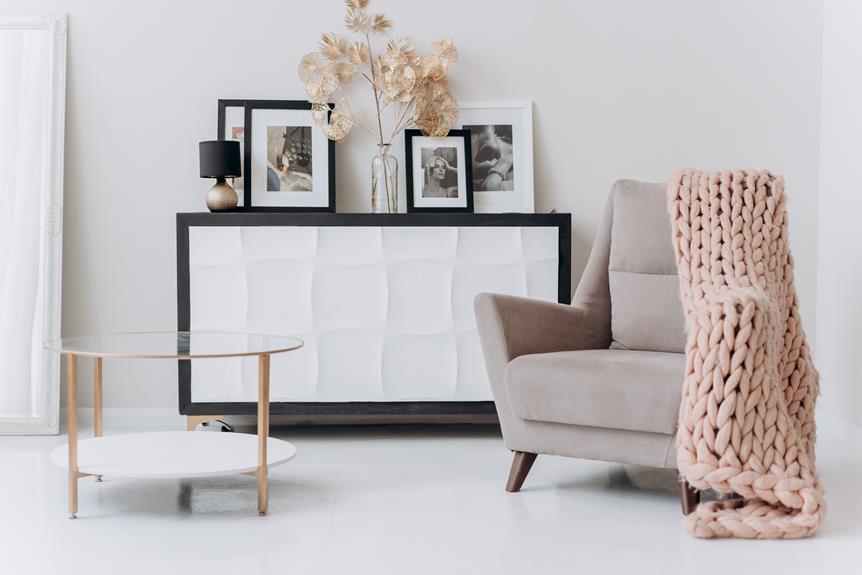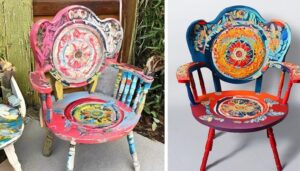Welcome to an exploration of the world of timeless chair designs that have come to define modern furniture.
These iconic chairs, created by visionary designers from around the globe, continue to captivate with their style, innovation, and craftsmanship.
From the Bentwood Thonet 209 Armchair to the Barcelona MR90 Chair, each design tells a fascinating story of its origins, designers, and provenance.
Join us as we delve into the rich history and enduring appeal of these remarkable chairs that have left an indelible mark on the industry.
The Bentwood Thonet 209 Armchair (1859)
The Bentwood Thonet 209 Armchair (1859) is renowned for its innovative use of bentwood and its influence on modern furniture design. Designed by Michael Thonet in Austria, this armchair has become popular as the quintessential restaurant chair.
Its emergence marked a significant innovation in chair design, as it was one of the first mass-produced chairs made of bentwood. The chair’s simple and elegant design, coupled with its lightweight yet sturdy construction, has made it a timeless classic.
The use of bentwood allowed for graceful curves and organic shapes, setting a precedent for future furniture designs. The Bentwood Thonet 209 Armchair remains an iconic piece that continues to inspire contemporary furniture makers.
The Wassily B3 and Cesca Chair (1925 and 1928)
Designed by Marcel Breuer, the Wassily B3 and Cesca Chair (1925 and 1928) are two iconic pieces of furniture that have made significant contributions to the world of modern design.
- The Wassily B3 chair, also known as the Model B3 chair, is a revolutionary piece that was the first successful cantilever chair. Its tubular steel design challenged traditional notions of furniture construction and introduced a new aesthetic to the design world.
- The Cesca Chair, on the other hand, is a testament to the elegance and simplicity of modern design. With its cane seat and backrest, curved steel frame, and minimalist form, it embodies the principles of Bauhaus design.
- Both chairs are celebrated for their innovative use of materials, pushing the boundaries of what was traditionally considered suitable for furniture.
- Their enduring popularity and influence on subsequent chair designs highlight their timeless appeal and enduring relevance in the world of modern furniture.
The Eileen Gray Transat Chair (1927)
An iconic chair that showcases a sleek frame and an adjustable headrest, the Eileen Gray Transat Chair (1927) is a timeless piece of modern furniture.
Designed by Eileen Gray and originating from France, this chair was originally used as a deck chair at Gray’s villa.
The Eileen Gray Transat Chair is known for its elegant and minimalist design, featuring a chrome-plated tubular steel frame and a comfortable, slung leather seat.
The adjustable headrest adds an extra level of comfort and versatility to the chair.
With its clean lines and functional design, the Eileen Gray Transat Chair remains a classic and sought-after piece in the world of modern furniture.
The Grand Confort LC2 (1928)
Inspired by gentlemen’s club chairs, the Grand Confort LC2 (1928) flaunts a tubular steel exoskeleton and open frame design. This iconic chair, designed by Charlotte Perriand, Le Corbusier, and Pierre Jeanneret, has stood the test of time and remains a symbol of modern furniture.
Here are four reasons why the Grand Confort LC2 continues to evoke an emotional response in the audience:
- Timeless elegance: The chair’s sleek lines and minimalist aesthetic exude sophistication and elegance, making it a timeless addition to any interior.
- Unparalleled comfort: With its plush cushions and ergonomic design, the Grand Confort LC2 offers unparalleled comfort, inviting users to relax and unwind.
- Architectural masterpiece: The tubular steel exoskeleton not only adds strength and durability but also showcases the chair’s architectural beauty, turning it into a work of art.
- Enduring influence: The Grand Confort LC2 has not only inspired countless furniture designs but has also become a symbol of the Modernist movement, leaving a lasting impact on the world of design.
The Barcelona MR90 Chair (1929)
The Barcelona MR90 Chair (1929) is a striking piece of furniture that combines timeless design with innovative materials and craftsmanship. Designed by Ludwig Mies van der Rohe and Lilly Reich for the German pavilion at the 1929 International Exhibition in Barcelona, this chair features a scissor-shaped X-frame design and chrome-plated steel.
Its sleek and minimalistic aesthetic, along with the use of high-quality materials, makes it a true icon of modern furniture design. The Barcelona MR90 Chair is not only visually appealing but also provides exceptional comfort with its leather upholstery and generous proportions.
It has become a timeless classic that continues to be celebrated for its elegance and sophistication in both residential and commercial settings.
The Knoll MR90 Chair (1953)
Manufactured by Knoll, the Knoll MR90 Chair (1953) showcases seamless welded joints in its frame, highlighting the chair’s exceptional craftsmanship and durability. This iconic design by Ludwig Mies van der Rohe is a testament to his modernist approach and attention to detail.
Here are four reasons why the Knoll MR90 Chair continues to captivate and inspire:
- Timeless Elegance: The chair’s clean lines and minimalist aesthetic make it a timeless addition to any space.
- Comfort and Support: The chair’s ergonomic design ensures maximum comfort and support for the user.
- Versatile Design: The chair’s understated elegance allows it to seamlessly blend with various interior styles and settings.
- Enduring Quality: The chair’s seamless welded joints and high-quality materials ensure its longevity and durability.
The Eames LCW Chair (1945)
Developed using a machine called the Kazam! Machine for molding plywood, the Eames LCW Chair (1945) exhibits a groundbreaking approach to furniture design. Created by Charles and Ray Eames, this iconic chair showcases their innovative use of materials and their emphasis on form and function.
The LCW, which stands for Lounge Chair Wood, features a curved molded plywood seat and backrest, supported by a sleek metal frame. The chair’s organic shape and ergonomic design ensure maximum comfort and support.
The LCW Chair is a testament to the Eames’ dedication to creating furniture that is both aesthetically pleasing and practical. With its timeless design, the Eames LCW Chair continues to be a sought-after piece in modern interiors.
Get inspired, find more designs and ideas in our Home and DIY section




